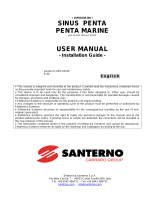
MI00111 -E3 ENGLISH - 3/8
The auxiliary output has been designed in order to pilot an indicator, a relay of greater
power or the input of a supervisor control system. Through this output the K109 TC
instrument may generate an alarm or may be utilized like a thermostat. The stateNormal
of the output depends on the configuration for the fault of the primary output, so on the
setting of the correspondent dip-switch SW2.7 (see table).Details of Dip-Switch SW2.7
Since during the regulation of the threshold the primary output assumes the value of the
threshold, it is advisable to connect an instrument of measure (a multimeter for example)
to the primary output. Therefore the value in V or mA of the threshold depends on the
scale of the chosen output. The switching is instantaneous to the overcoming of the set
up value.
Description
AUXILIARY OUTPUT
The regulation of the threshold is performed through a button present under the frontal
cover and accessible through the hole by using a little screwdriver. The operation has to
be performed when the module is correctly supplied. It will be necessary to follow the next
procedure:
Pressed and released the button, the primary output starts to represent the value of
threshold. At this point the red led flashes slowly.
If within 5 seconds there is no pression, the system returns to the normal
functioning.
On the contrary at every further pressure, there is an increment or decrement of
approximately 0,2 %; the direction of the variation depends on the Normal state of the
output and therefore on the dip-switch SW2.7 so that the commutation occurs exactly
at the set value, leaving the effect of the hysteresis only at the reset.
If the button is not released but continues to be pressed, after 2 seconds a
continuous increment of 3% starts.
Reached the maximum/minimum value of the chosen scale, the cycle starts again.
During the regulation of the threshold, the auxiliary output follows the normal
functioning, opening and closing, as previously set.
After 5 seconds of button’s inactivity, the set value is memorized and the instrument
continues with the normal functioning.
Note:
The threshold may not be modified in case of internal fault. If the power supply is not
sufficient during the regulation or before the 5 seconds of button’s inactivity are elapsed,
the new value will not be memorized.
Setting of the threshold
Details of Dip-Switch SW2.7
Regulation Type
Furnace (*) Towards the high Closed (led ON) Decrement
Normal State Set Threshold
Refrigerator (*)
Towards the bottom Opened (led OFF) Increment
OFF
SW2.7
ON
Fault
(*) In case of choice of direct output (0/4..20 mA), 0/1..5/10 V)









